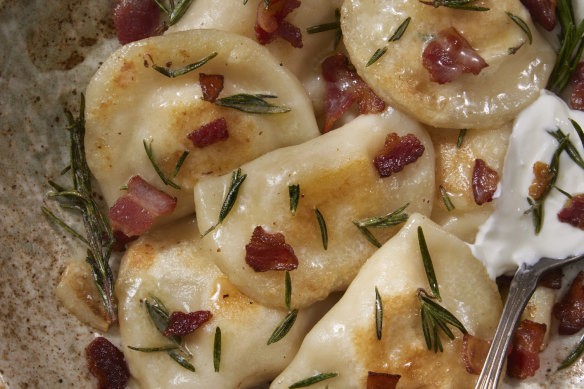This was published 2 years ago
Foodies: You can’t take yourselves seriously until you’ve made these
The Dish
Pierogi, Poland
Plate Up
Bold statement: you can’t take yourself seriously as a food culture until you’ve made some dough and stuffed it with meat. So many of the world’s great cuisines include the dumpling, or something similar. China, of course, has many. Japan adapted them to become gyoza. In India they have samosas; in Nepal, momos. In Latin America there are empanadas. In Italy, you have tortellini and ravioli. In Turkey there’s manti. And in Poland: pierogi. Pierogi are made with small sheets of unleavened dough, which are topped with savoury or sweet fillings — the most popular is probably pierogi ruskie, filled with potato and cheese — and then folded into little half-moon shapes and boiled until cooked (and sometimes finished off with a quick sear in a saucepan). The pierogi are served with oil or bacon fat for the savoury version, and sour cream and sugar for the fruity iteration.

Garlic and cheddar pierogi.Credit: iStock
First Serve
The queue of regions ready to claim they invented pierogi is a long one. We’re talking Romania, Russia, Lithuania, Ukraine, Slovakia and of course Poland. Some say pierogi were inspired by Chinese dumplings. Others say the idea came from the Tatars of Russia (who could also have pinched it from China). The more spiritual believe a Ukrainian saint is responsible. What we do know is that pierogi, or something similar, were being made in Poland as far back as the 13th century, and were mentioned in Polish cookbooks in the late 17th century.
Order There
If you’re stopping through the Polish capital of Warsaw, Czerwony Wieprz is the perfect spot to sample traditional pierogi — though of course, you’ll find this dish almost everywhere.
Order Here
Sydneysiders should give pierogi a try at Na Zdrowie in Glebe. In Melbourne meanwhile, stock up on Polish dumplings at the aptly titled Pierogi Pierogi.
One More Thing
Though pierogi are an everyday treat in Poland, they’re especially important during Christmas celebrations. There are two meat-free varieties traditionally served for Yuletide feasts: one filled with sauerkraut and dried mushrooms, and another smaller version with just dried mushrooms.
Sign up for the Traveller Deals newsletter
Get exclusive travel deals delivered straight to your inbox. Sign up now.